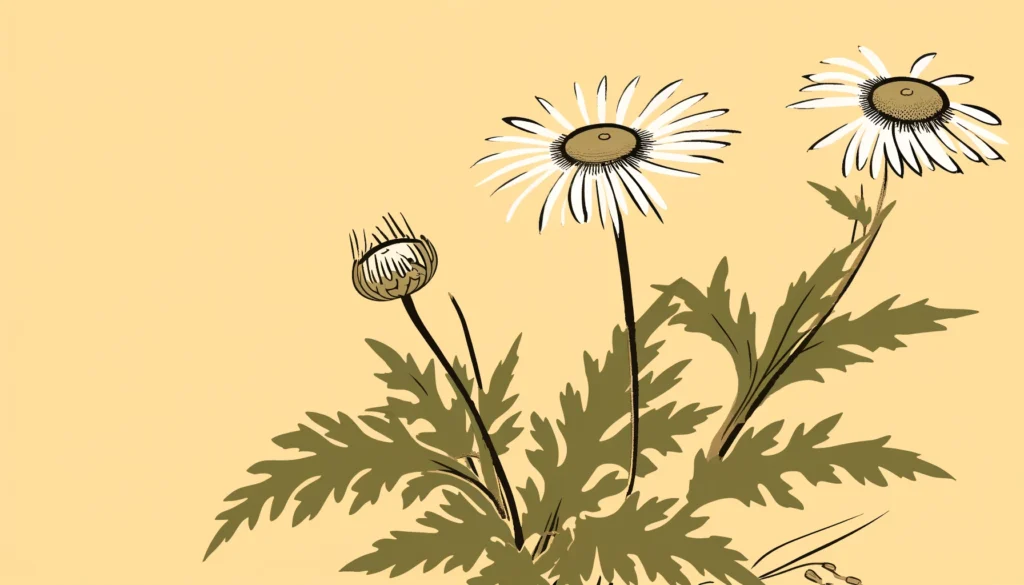

Home » Cat Plants » Is the Chamomile Plant a Hazard for Cats?

Chamomile (Matricaria chamomilla), also known as German chamomile, is a flowering plant commonly used to make herbal teas. While chamomile is generally safe for human consumption, it can be a toxic plant to cats.
Chamomile contains several compounds that are poisonous to felines, including volatile oils, tannic acid, anthemic acid, and bisabolol.
This daisy-like plant is often found in herbal tea blends, supplements, and garden beds.
Ingestion may cause mild gastrointestinal upset, but is generally not life-threatening.
Ingestion can result in mild symptoms like vomiting, diarrhea, or drooling. Rarely fatal but may require veterinary care.
Eating these plants can lead to more pronounced symptoms like abdominal pain, lethargy, or difficulty breathing. Veterinary intervention may be necessary.
Ingesting even small amounts can cause severe symptoms like organ damage, seizures, or cardiac failure without rapid treatment.
All parts of these plants are extremely poisonous to cats and can quickly lead to death, even with immediate veterinary care.
** Please note: Please note that toxicity level can vary based on the amount ingested and the specific cat. It's always best to keep these plants completely inaccessible to cats and seek immediate veterinary care or call the poison hotline if you suspect your cat has ingested any part of a toxic plant.
If a cat ingests chamomile, it may experience a range of symptoms due to the plant’s toxic principles. Common signs of chamomile poisoning in cats include:
In severe cases or with long-term exposure, chamomile toxicity can lead to bleeding tendencies and liver damage.
If you suspect your cat has ingested chamomile, it’s crucial to seek veterinary care promptly. Your veterinarian will likely follow these steps to diagnose chamomile poisoning:

A: Yes, cats can be allergic to Chamomile. Symptoms of an allergic reaction may include itching, sneezing, and skin irritation.
A: Yes, Chamomile is toxic to cats. Ingesting any part of this plant can cause symptoms such as vomiting, diarrhea, and lethargy.
A: Symptoms of Chamomile poisoning in cats include vomiting, diarrhea, excessive drooling, and lethargy. In severe cases, it can cause bleeding tendencies. Immediate veterinary care is recommended if ingestion is suspected.
A: To prevent contact, ensure that Chamomile is not present in your home or garden. Keep your cat indoors or monitor outdoor activities closely to avoid exposure.
A: If your cat ingests Chamomile, contact your veterinarian immediately. Do not induce vomiting unless instructed by a veterinary professional. Immediate medical attention is necessary.
A: Yes, Chamomile is commonly found in homes and gardens as an herbal plant. It is important to ensure this plant is kept out of reach of cats to prevent accidental ingestion.
Chamomile has a long history of use dating back to ancient times. The ancient Egyptians, Greeks, and Romans used chamomile for its medicinal properties, such as treating anxiety, colds, insomnia, gingivitis, ulcers, and inflammatory bowel disease.
Chamomile has been used in herbal teas for thousands of years, and its popularity as a calming and soothing herb continues to this day. However, while chamomile may offer benefits to humans, it is important to remember that it can be harmful to cats.
Please note: The information shared in this post is for informational purposes only and should not be considered as veterinary medical advice.
🐾 A hilarious or heart-melting cat video
🐾 Our latest paws-on review of a cool cat toy